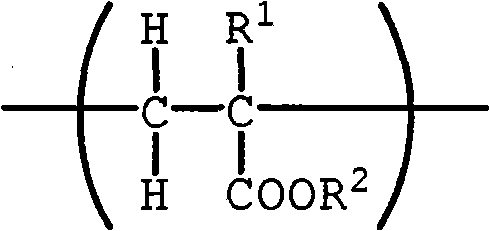Releasing agent composition and releasing material
A technology of composition and peeling agent, applied in the directions of adhesives, chemical instruments and methods, film/sheet-like adhesives, etc., can solve the problems of inability to peel, low production efficiency of synthetic leather, reduced peeling ability, etc., and achieve surface state Excellent, excellent peelability, the effect of maintaining peelability
- Summary
- Abstract
- Description
- Claims
- Application Information
AI Technical Summary
Problems solved by technology
Method used
Image
Examples
Embodiment
[0097] The effects of the present invention will be described using the following examples and comparative examples. However, the technical scope of the present invention is not limited to the following examples.
[0098] In the following Examples and Comparative Examples, first, hydroxyl-containing acrylic resins having different hydroxyl values, glass transition temperatures, and weight-average molecular weights were synthesized. Then, using the synthesized hydroxy acrylic resin, release agent compositions having different compositional ratios of hydroxyl group-containing acrylic resin, amino resin, silicone resin, and alkyd resin were prepared. Further, a release material was produced using the release agent composition, and the performance evaluation of the release material was performed on glossiness, surface condition, initial release ability, durability for repeated use, and resistance to dimethylformamide.
[0099] (Synthesis of Acrylic Resin)
Synthetic example 1
[0101] 600 parts by mass of butyl acetate was charged into a reaction container equipped with a stirrer and a cooling pipe, and heated and stirred while blowing in nitrogen gas, and kept at 100°C. Next, add 150 mass parts n-butyl acrylate, 250 mass parts 2-hydroxyethyl methacrylate, 100 mass parts methyl methacrylate, 500 mass parts styrene and azobisisobutyronitrile to another container, mix homogeneous, thus making a monomer-catalyst mixed solution. This monomer-catalyst mixed solution was added dropwise to the above-mentioned reaction vessel at a uniform rate over 2 hours. After maintaining the temperature for 3 hours, the heating residue (JIS K5407) was measured to confirm that the degree of polymerization was 100%. Then, 400 parts by mass of butyl acetate was added and diluted to obtain an acrylic resin (A) having a resin concentration of 50%. The hydroxyl value of the acrylic resin is 105 mgKOH / g (converted to 100% of the resin component), the glass transition temperat...
Synthetic example 2
[0103]The mixing ratio of the monomers in the monomer-catalyst mixed solution is set as 250 parts by mass of n-butyl acrylate, 160 parts by mass of 2-hydroxyethyl methacrylate, 230 parts by mass of methyl methacrylate, 350 parts by mass of benzene An acrylic resin (B) was obtained by performing solution polymerization in the same manner as in Synthesis Example 1 above except for ethylene and 10 parts by mass of methacrylic acid. The acrylic resin (B) had a hydroxyl value of 69 mgKOH / g, a glass transition temperature of 40° C., and a weight average molecular weight of 49,000.
PUM
| Property | Measurement | Unit |
|---|---|---|
| hydroxyl value | aaaaa | aaaaa |
| glass transition temperature | aaaaa | aaaaa |
| hydroxyl value | aaaaa | aaaaa |
Abstract
Description
Claims
Application Information
 Login to View More
Login to View More - R&D
- Intellectual Property
- Life Sciences
- Materials
- Tech Scout
- Unparalleled Data Quality
- Higher Quality Content
- 60% Fewer Hallucinations
Browse by: Latest US Patents, China's latest patents, Technical Efficacy Thesaurus, Application Domain, Technology Topic, Popular Technical Reports.
© 2025 PatSnap. All rights reserved.Legal|Privacy policy|Modern Slavery Act Transparency Statement|Sitemap|About US| Contact US: help@patsnap.com



